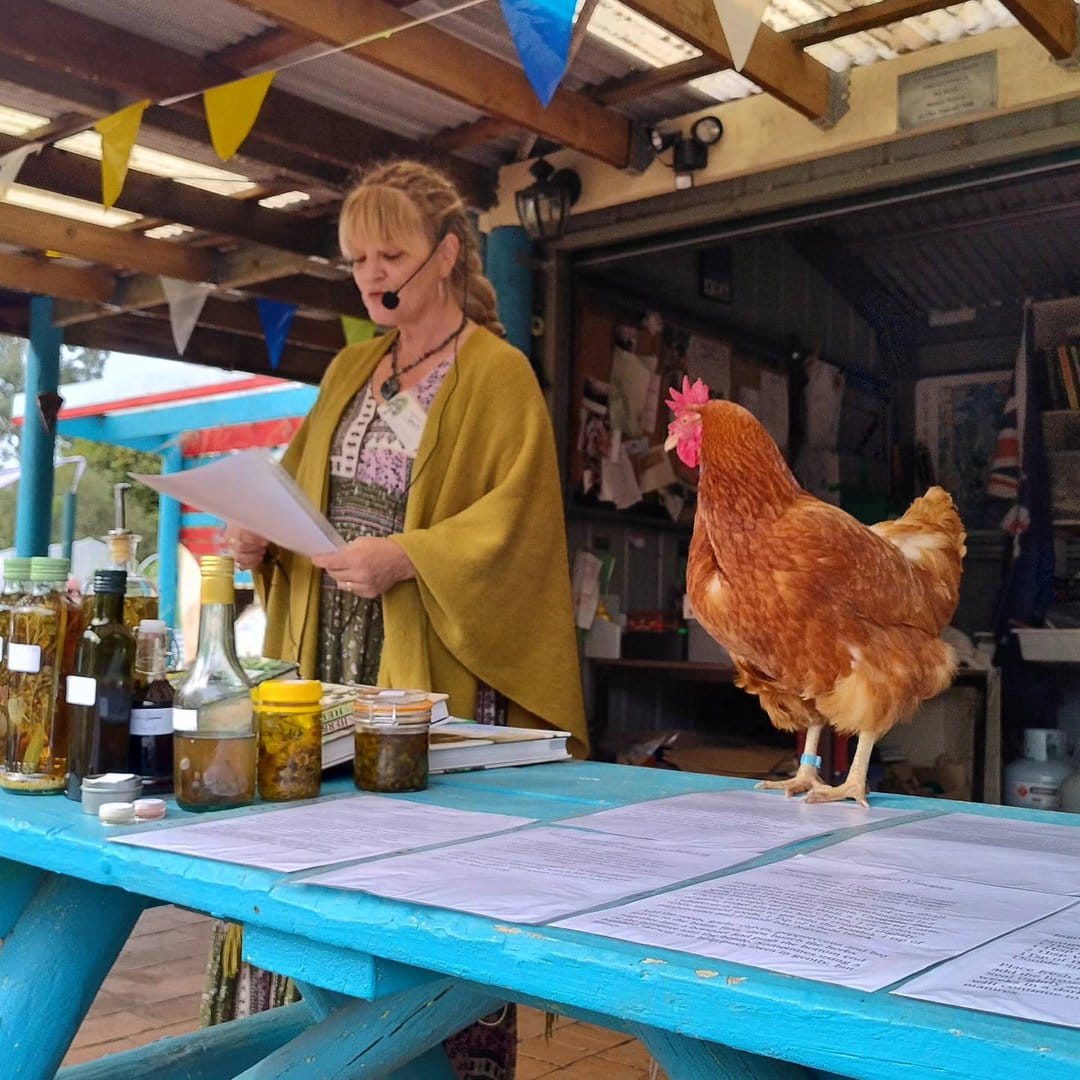We had a fantastic time at our last gathering at San Remo Community Garden. The delicious and delightful space was host to an inspiring and engaging talk by our President Jen Jones, and she has kindly produced the talk below for those who were unable to make it, minus her co-teacher chicken sadly, but still…Enjoy!
Many common plants qualify as a herb. The dictionary defines them as ‘ Any plant with leaves, seeds or flowers that is used in flavouring food, used for medicine or perfume’.
The botanical definition is ‘Any seed bearing plant that does not have a woody stem and dies down to the ground after flowering.’ The banana is the world’s largest herb! Although I can think of at least one plant we consider a herb that does not fit into that description….Rosemary!
Before the drug companies and pharmacists were created, humans evolved using the herbs growing around them for a variety of purposes; including flavouring food, making and dying of textiles, rope and twine production and medicine. The early experiments in this were probably a bit of a hit and miss affair though, with some very careful observations being made and that knowledge passed on to their offspring. Researchers have found evidence of yarrow, chamomile and poplar on the tooth plaque of Neanderthals dating back to 60 000 BCE.
Down the track a few thousand years, humans started writing these observations down and the shareable knowledge increased exponentially. One of the oldest and most famous is ‘The Herbal’ published in 1597 by John Gerard. Worth a look if you are a plant and herbal nerd as well as into history like me!
The pharmaceutical industry was born in the mid 1800’s and continues to this day to investigate herbs to synthesise, to create reliable medicine for the masses.
So even with all this documented history, there are still many herbs whose medicinal properties are considered ‘old wives tales’ or ‘folk medicine’….and that is mainly due to a lack of funding and interest to study them. Even today new drugs are being discovered as compounds in plants, some of them common place and right under our noses!
It is in this regard that I urge you to do your own research on the herbs you wish to use, whether it’s for a specific ailment or for culinary purposes. What you discover might surprise you! And as a word of caution, if you do have an underlying condition, please consult with your doctor or specialist before taking something, in case it contraindicates with your prescription medication.
So today I’d like to give you a brief rundown on different ways to use those herbs in your garden. And I will provide you with a couple of my own recipes to take home to get you started. They all can be made using simple utensils from your kitchen and ingredients available at the shops or online.
Drying
Firstly, there are a few different ways to prepare your herbs for use. Some can be very simply cut, tied in a bunch and hung up somewhere dry and warm, and then stored in an airtight container to be used in times when fresh herbs are not available. You can also use an clean pillowcase turned inside out to hang the herbs for drying, just make sure it’s in a well ventilated area and shook regularly to prevent mould. I find dried herbs work better than fresh for baking, roasting and slow cooked dishes. You can also dehydrate fresh herbs for storage using a dehydrator or your oven set to 60-70c. When dehydrating, you must make sure your plant material is bone dry before storing, or else harmful mould can grow, ruining your harvest. I like to save the little desiccant sachets found in vitamin bottles to add to the containers to add another level of assurance.
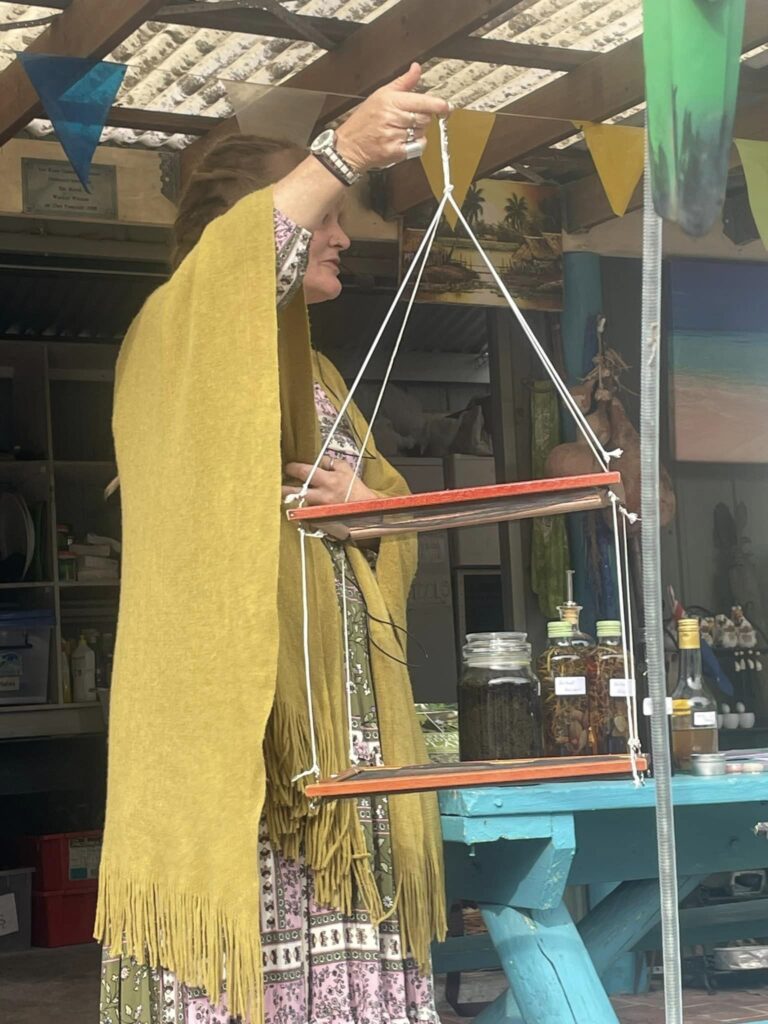
Freezing
For using fresh herbs for either culinary or medicinal purposes, I prefer to harvest them on sunny warm days in the afternoon; so the plant’s natural oil content is at it’s peak. You can blend or chop them finely, pack them into ice cube trays and freeze for that fresh herb taste all year.
Teas
There are a plethora of different herbs and flowers that can be used in herbal tea. It really depends on your personal tastes and medical requirements if you are drinking it for a specific health reason. I suffer with a chronic illness and found this to be my favourite tasting while doing me some good recipe…
Jen’s Favourite Herbal Tea for when I’m feeling crappy…..
For a teapot or plunger, I gather:
- Two fresh elderflower flower heads
- Several fresh Raspberry or Blackberry leaves
- A small bunch each of fresh Lemon Thyme, Lemon Balm and common Thyme
- Two teaspoons of Chamomile flowers (or two teabags)
- Allow to infuse for 10 minutes in boiling filtered water.
- Then pour into a cup which has 1 teaspoon of raw honey and 1 tablespoon of lemon juice added.
- Sip hot or cold
Oils & Vinegars
Herbed Vinegars and oils are a great way to preserve the flavour of herbs to use in cooking. For vinegar, you simply cover the herbs of your choice with the vinegar or blend of vinegar’s (making sure no plant matter is floating to prevent mould from growing), and allow that to age somewhere out of direct light. You can use it as soon as it tastes the way you like it, but I like to age mine up to 12 months before using it. At this point you can choose to strain it and rebottle it if you’re giving it as a gift, but if it’s for personal use I often don’t!
Herbed Vinegars
Ingredients, per 500ml bottle:
- 1 Tbsp of Malt vinegar
- 2 Tbsp of Apple Cider Vinegar
- 2 Tbsp of White Wine Vinegar
- Double Strength White vinegar
- Fresh herbs of your choosing. Gather a small piece of each or any combination of culinary herbs you like. My favourite combination is a sprig each of Rosemary, Thyme, Oregano, flat leafed Parsley, Perennial Basil, a couple of Garlic Chives, a couple of Onion Chives, 1 or 2 cloves of garlic either sliced in half or crushed slightly (whatever is easiest to get into the bottle), 1 tsp of white mustard seeds, 1 Tsp of whole black peppercorns and 2 small bay leaves.
- Add the seeds, garlic cloves, peppercorns and bay leaves to the bottle first, then bunch the herbs together into a bouquet and push the bottom end of the bouquet into the bottle. Sometimes using a bamboo skewer can help push them in gently, but firmly.
- Then add the vinegar’s in one at at time, topping up to full with the white vinegar last. Seal with a tightly fitting lid and shake well. Store in a spot out of direct light until ‘aged’ to your taste. I like to start using them at around 12 months old.
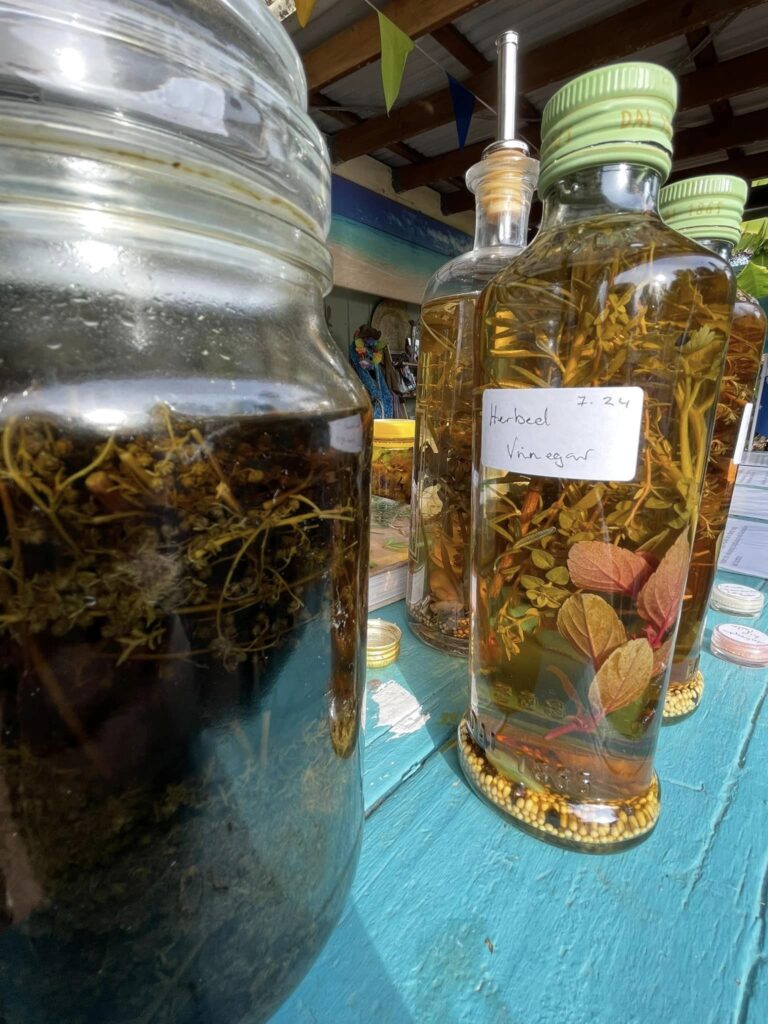
Mint Sauce
Ingredients, per 500ml bottle:
- Sprigs of fresh Mint
- 1 Tbsp Apple Cider Vinegar
- 1 Tbsp Malt Vinegar
- 2 Tbsp White Wine Vinegar
- 1Tsp of Brown Sugar
- Double Strength White vinegar to top up
- Place fresh mint into your bottle as above, then add the brown sugar, followed by the vinegars.
- Seal tightly and shake well before storing for 6-8 weeks in a dark spot until the flavour develops. It will continue to develop and age it’s flavour as it matures.
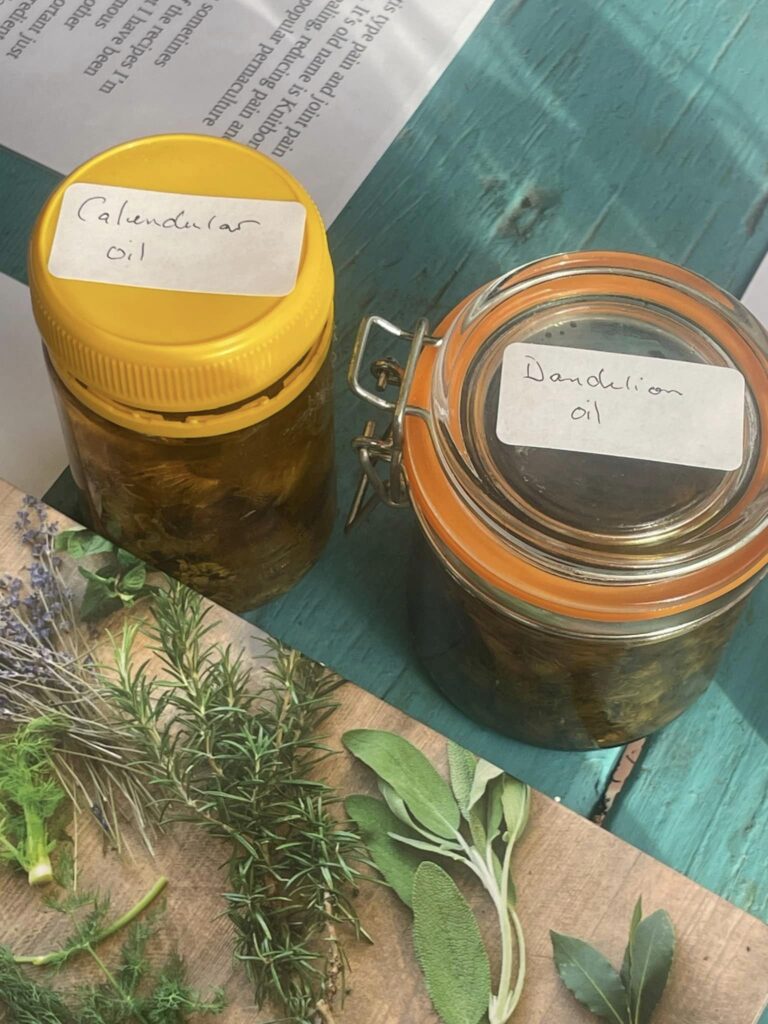
For infused oils, I like to either warm the oil very gently with the chopped herbs in it on a stove top (but you must be very careful not to cook the herbs) or pack them once wilted for a day into a glass jar, fill the jar with your chosen oil, seal the jar and place onto a trivit in a slow cooker. Fill the slow cooker with water until it comes up halfway on the jar, place the lid on and set the temperature to low for a 4 hour period, then turn it to the warm setting overnight. In the morning, you will have a perfect herbal oil infusion which just needs straining. This method is effective for both culinary and medicinal uses. Both infused oils and vinegars will keep almost indefinitely if kept sealed and out of direct light.
Tinctures
Tinctures are made by dissolving medicinal properties out of herbs and spices using a solvent such as alcohol, vinegar or glycerin. Alcohol is most commonly used and the higher the alcohol content, the longer lasting the tincture will be. Sometimes a % of water is needed, sometimes it is not and is usually herb specific ( which is why I urge you to do your own research) And that is also the case with the parts of the plant that is needed. Sometimes it’s the leaves that are used, or bark, or fruit or seeds.
Usually, tincture making is very simple and only requires the plant material, a jar with a lid and ethanol of the highest quality you can obtain. For most people, that is a high grade vodka, gin or brandy. The jar is packed with wilted for a day plant material, covered with the alcohol and sealed. Then it is left to macerate ( which is just a fancy word for infuse) out of direct light for 4-6 weeks. After that it is strained, filtered through coffee filter paper and bottled. Tinctures have a shelf life of 1-5 years depending on the herbs used and the strength of the alcohol.
Elderberry Syrup
Ingredients:
- 1/2kg of Elderberries
- Juice of a lemon
- 250g of raw honey
- De-stem the berries and place them in a saucepan with just enough filtered water to cover them.
- Bring to a boil, then reduce heat to a gentle simmer for 20 mins until the berries were soft.
- Use a potato masher to squish the berries while hot before pouring the whole lot through a jelly bag to strain out the skins and seeds. Squeeze as much liquid as you can from the pulp.
- Return the liquid to the stove top, add the honey and lemon juice and bring back to a rolling simmer to reduce it a little further before pouring into sterile dark glass bottles.
It will keep all year in a fridge, outside of the fridge it may ferment once opened.
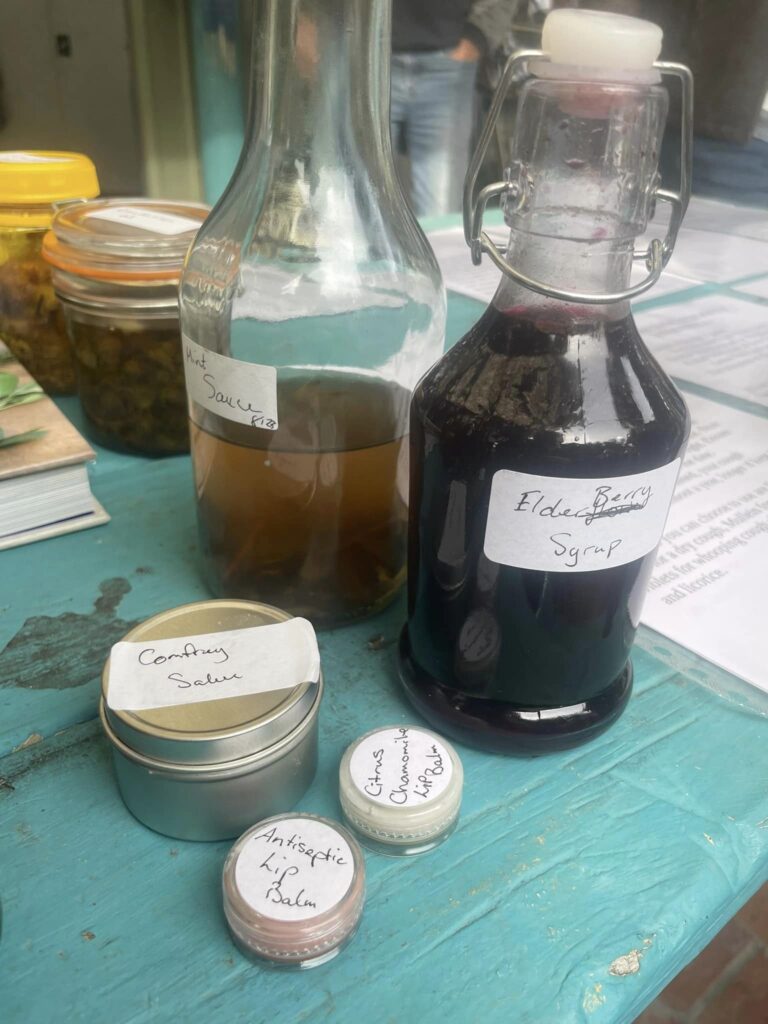
Creams and salves are usually made with an oil based infusion and a natural hardening/thickening agent such as beeswax.
A salve is allowed to cool once poured into it’s container and left to set. A cream is whipped by whisk or electric mixer, while it thickens and cools. The ingredients can be anything you like depending on skin types, it’s intended use and the herbs available. For example; A good salve for arthritis type pain and joint pain will almost always have Comfrey in it. It’s old name is Knitbone and has a well documented history of healing, reducing pain and speeding up the repair of fractures. It’s a popular permaculture plant due to it’s myriad of uses.
Lip Balm
Ingredients:
- 2 tablespoons of Almond oil or coconut oil or combination (22g)
- 1 heaped tablespoon of grated beeswax (11g)
- 1 heaped tablespoon of copha (11g)
- 5-10 drops of chosen essential oils
- Place the first 3 ingredients in a heat proof bowl in a double boiler until melted and well combined.
- Remove from heat and add essential oil/s and stir through. Pour immediately into prepared containers and leave until completely set.
Magnesium Lotion
Ingredients:
- 1⁄2 cup magnesium flakes
- 3 TBSP Boiling water
- 2 TBSP Beeswax
- 3 TBSP Shea Butter
- 1⁄4 cup coconut oil
- A few drops of your favourite essential oil
- Add magnesium to the boiling water in a heat proof bowl, and stir to dissolve completely. Set aside.
- Place another heat proof bowl over a small pot of simmering water and add the beeswax, shea butter and coconut oil. Stir until everything has dissolved.
- Remove from the heat, add essential oil and let sit for 30 minutes to set slightly, then beat with an electric mixer while adding in the magnesium water.
- Store in glass jars away from direct light.
Syrups are made with sugar or honey and can sometimes ferment, so careful observation is needed. One of the recipes I’m including today is a natural herbal cough syrup that I have been making for over 30 years. Apart from the already famous antimicrobial and antibacterial qualities of honey, the other ingredients shouldn’t be mistaken as mundane or unimportant just because they are common place. Thymol is the active ingredient and essential oil in thyme. It is well known for it’s antioxidant, antibacterial and anti inflammatory activity, it’s an active ingredient still used in modern cough and throat medications.
Herbal Cough Syrup
Ingredients:
- I only use unprocessed locally sourced raw honey.
- 7g Fresh Thyme 6 Cloves
- 1 TSP Fennel Seeds
- 1 Cinnamon Stick
- 1 TSP Ground Ginger
- 1⁄2 TSP Crushed Garlic
- 450g Honey
- 1⁄2 cup water
- Place all the herbs & spices in a pot with water. Bring to the boil, and then reduce heat to a gentle simmer for 5 mins.
- Strain the mixture, then add the honey to the reserved liquid whilst it is still hot.
- Store in dark sterile bottles away from direct light. Ensure you mark each bottle clearly with the date.
If sterile practices are maintained, your cough medicine should last almost a year, longer if kept in the fridge.
Other herbs you can choose to use are Fenugreek seeds for a dry cough, Mullein for a chesty cough, violets for whooping cough along with Marshmallow and licorice.
For further reference…
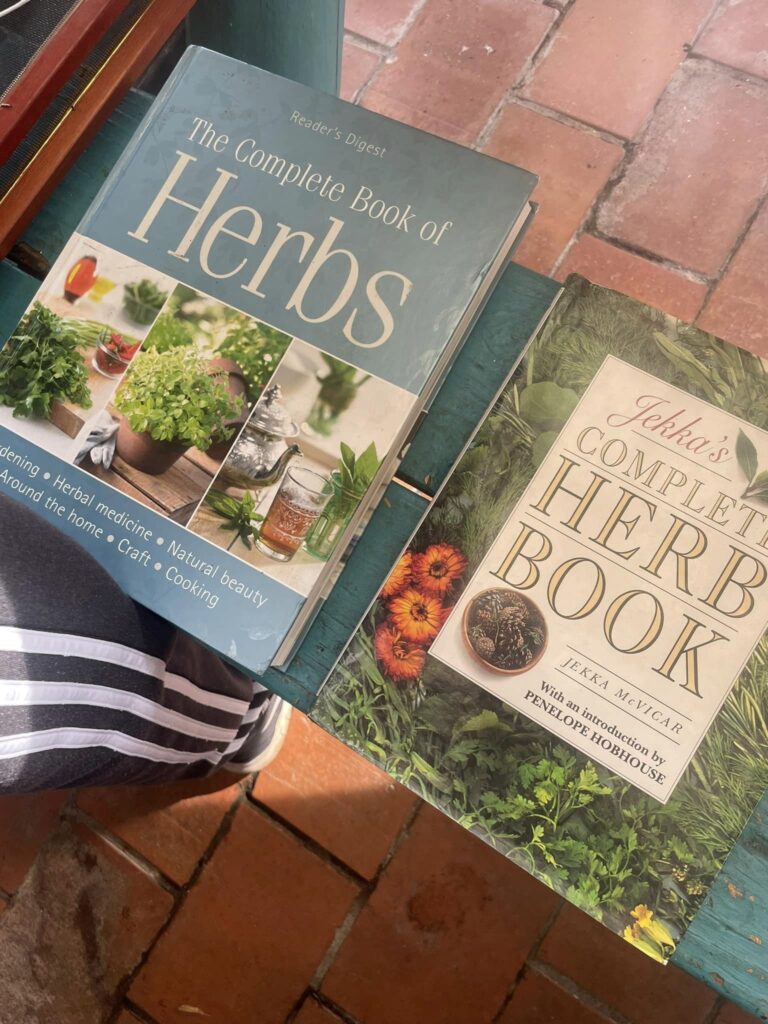
I love books about herbs. No two are alike in content and that makes me want to collect them all!
But for beginners, I recommend Jekka’s Complete Herb book By Jekka McVicar or The Readers Digest book ‘Natures Medicine’. Both are full of useful and important information, as well as some recipes, with the former also giving a brief history on some of the more notable herbs.
Words and images by Jen and Thea

